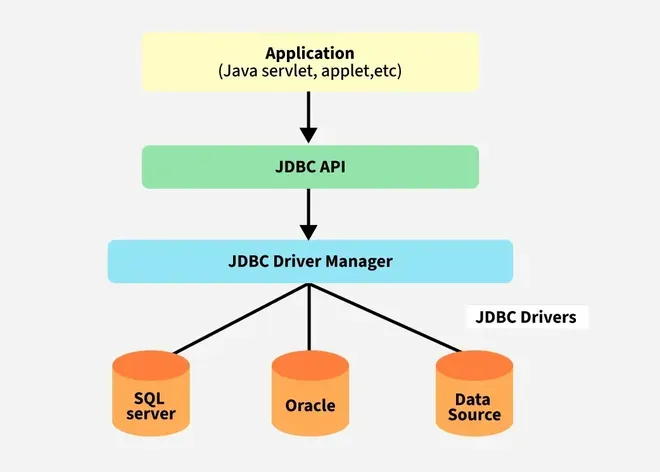Federal Reserve System and Monetary Policy Quiz Questions
Chapter 4: Federal Reserve and Monetary Policy Questions
US Financial Institutions and Central Bank Functions
1. Fannie Mae and Ginnie Mae Functions
The Federal National Mortgage Association (Fannie Mae) and Government National Mortgage Association (Ginnie Mae):
- issue mortgages directly to consumers.
- provide assistance on down payments to help consumers get into the housing market.
- issue mortgage-backed securities to fund the mortgages that they purchase from financial institutions.
- purchase homes directly
JDBC Architecture and Components Explained
JDBC is an API that helps applications communicate with databases. It allows Java programs to connect to a database, run queries, retrieve, and manipulate data. Because of JDBC, Java applications can easily work with different relational databases like MySQL, Oracle, PostgreSQL, and more.
JDBC Architecture

Components of JDBC Architecture
Explanation of Components
- Application: This can be a Java application or servlet that communicates with a data source.
- The JDBC API: It allows Java programs to execute
Core Physical Attributes for Peak Athletic Performance
Key Physical Attributes for Athletes
- Basic Physical Attributes:
- Stamina
- Strength
- Speed
- Flexibility
- Specific Physical Attributes:
- Coordination
- Balance
- Relaxation
Understanding Athletic Stamina
Stamina is the attribute that allows us to sustain physical exercise for a prolonged time.
Anaerobic Alactic Stamina
- It is the first energy pathway used to get energy.
- It involves activities from zero to 10 seconds, no longer.
- Intensity is between 90-100% of maximum.
- Oxygen is not present.
- Lactic acid is not produced.
- Examples:
Memory Systems: Autobiographical, Implicit, and Explicit Functions
Autobiographical Memory
Autobiographical memory refers to the conscious and active remembering of events related to one’s own life and personal past.
Traditional Procedure: Galton (1883)
- Requires a keyword and date to prompt a personal experience related to that word.
- The quality of memory is assessed by its vividness and level of detail.
- Problem: This method is considered too open.
Modern Procedures
Questionnaires (e.g., Baddeley)
Ask for personal information and autobiographical incidents from different
Read MoreThe Structure and Sources of English Law
The English Legal System: An Introduction
In most European countries, judges interpret the legal code. In the English legal system, however, judges have a dual role:
- They interpret the existing law, which is found in legislation and previous decisions of higher-ranking courts.
- They create the law by establishing legal principles that courts lower down the hierarchy must follow.
The Hierarchical Structure of English Courts
The English Court System is arranged in a hierarchical structure. The Supreme Court
Read MoreFoundations of Mexican Constitutional Law and Human Rights
Core Concepts of Mexican Jurisprudence
Human Rights and the Legal Order
Human Rights Definition
Human Rights are those freedoms, faculties, institutions, or claims related to primary or basic goods inherent to any person, simply by the fact of being human, intended to guarantee a dignified life.
Foundation of Human Rights
The foundation of human rights is the social value of human dignity.
Philosophical Foundations of Human Rights
- Natural Law
- Ethical or Moral Foundations
- Legal Positivism
Supreme Court and
Read MoreThe Political Regime of Francoism: Structure and Ideology
The Francoist Regime: Core Characteristics
International and Internal Recognition
The regime established by Franco had good relationships with its peers, namely Hitler’s Germany and Mussolini’s Italy. This external support was crucial, leading to Franco’s military victory and subsequent international recognition as a leader, as well as internal recognition as the savior of Spain.
The resistance did not constitute a major nuisance. The middle classes offered passivity, while economic elites and peasants
Read MoreEconomic and Social Transformation: 1750–1870
Causes of the Industrial Revolution
- The political situation reconciled the interests of the landed aristocracy and the bourgeoisie.
- Population growth increased the demand for products and labor.
- Improvements in transport and communications boosted trade and favored the formation of an internal market.
- Abundant availability of energy and mineral resources favored British industrial development.
- Agricultural transformation supported population growth.
Technical Change and Labor Organization
- Technical changes
Descartes’ Philosophy: Existence, Dualism, and the Mechanical World
Descartes: Existence of God and the World
The Ideas and the Idea of God
Descartes realizes that he is a finite and imperfect being, making his own mind aware of its limitations and imperfections. Ideas, according to Descartes, present thought in a double dimension:
- Objective: Ideas are pictures or representations of things.
- Subjective: Ideas, considered in themselves, cannot be false.
Descartes states that there are three kinds of ideas:
- Adventitious: Ideas that come from outside the subject (e.g., sensory
Aircraft Emergency Procedures: Forced Landing & Go Around Training
Simulated Forced Landing Procedures (SFL)
Objective
Prepare the student to handle and execute engine failure during solo flight, ensuring a safe approach and landing outside the traffic pattern.
General
Requires the presence of an instructor.
Task Checklist (Emergency Flow)
- Throttle
- Propeller
- Mixture
- Fuel Pump/Primer/Boost Pump (F PPB)
- Fuel Selector
- Establish Best Glide Speed
- Trim
Determine the wind direction and select a suitable landing site. Follow a traffic pattern, utilizing full flaps as appropriate.
